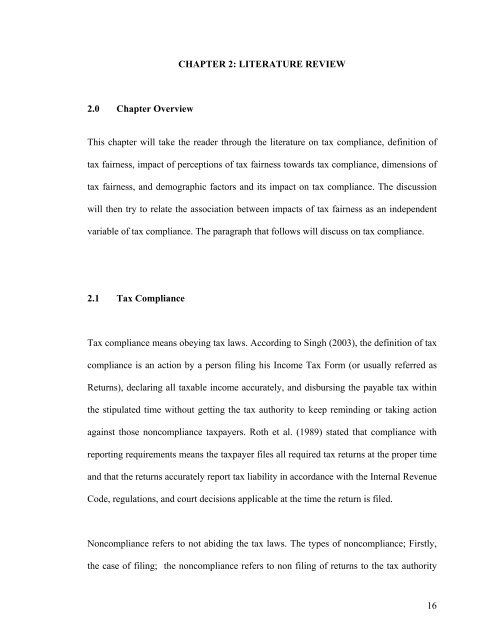1 CHAPTER 1: INTRODUCTION 1.0 Chapter ... - DSpace@UM
1 CHAPTER 1: INTRODUCTION 1.0 Chapter ... - DSpace@UM
1 CHAPTER 1: INTRODUCTION 1.0 Chapter ... - DSpace@UM
You also want an ePaper? Increase the reach of your titles
YUMPU automatically turns print PDFs into web optimized ePapers that Google loves.
<strong>CHAPTER</strong> 2: LITERATURE REVIEW2.0 <strong>Chapter</strong> OverviewThis chapter will take the reader through the literature on tax compliance, definition oftax fairness, impact of perceptions of tax fairness towards tax compliance, dimensions oftax fairness, and demographic factors and its impact on tax compliance. The discussionwill then try to relate the association between impacts of tax fairness as an independentvariable of tax compliance. The paragraph that follows will discuss on tax compliance.2.1 Tax ComplianceTax compliance means obeying tax laws. According to Singh (2003), the definition of taxcompliance is an action by a person filing his Income Tax Form (or usually referred asReturns), declaring all taxable income accurately, and disbursing the payable tax withinthe stipulated time without getting the tax authority to keep reminding or taking actionagainst those noncompliance taxpayers. Roth et al. (1989) stated that compliance withreporting requirements means the taxpayer files all required tax returns at the proper timeand that the returns accurately report tax liability in accordance with the Internal RevenueCode, regulations, and court decisions applicable at the time the return is filed.Noncompliance refers to not abiding the tax laws. The types of noncompliance; Firstly,the case of filing; the noncompliance refers to non filing of returns to the tax authority16
















